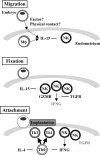Expression of endometrial immune-related genes possibly functioning during early pregnancy in the mare
- PMID: 23138119
- PMCID: PMC3943239
- DOI: 10.1262/jrd.2012-142
Expression of endometrial immune-related genes possibly functioning during early pregnancy in the mare
Abstract
Despite enormous efforts, biochemical and molecular mechanisms associated with equine reproduction, particularly processes of pregnancy establishment, have not been well characterized. Previously, PCR-selected suppression subtraction hybridization analysis was executed to identify unique molecules functioning in the equine endometrium during periods of pregnancy establishment, and granzyme B (GZMB) cDNA was found in the pregnant endometrial cDNA library. Because GZMB is produced from natural killer (NK) cells, endometrial expression of GZMB and immune-related transcripts were characterized in this study. The level of GZMB mRNA is higher in the pregnant endometrium than in non-pregnant ones. This expression was also confirmed through Western blot and immunohistochemical analyses. IL-2 mRNA declined as pregnancy progressed, while IL-15, IFNG and TGFB1 transcripts increased on day 19 and/or 25. Analyses of IL-4 and IL-12 mRNAs demonstrated the increase in these transcripts as pregnancy progressed. Increase in CCR5 and CCR4 mRNAs indicated that both Th1 and Th2 cells coexisted in the day 25 pregnant endometrium. Taken together, the endometrial expression of immune-related transcripts suggests that immunological responses are present even before the trophectoderm actually attaches to the uterine epithelial cells.
Figures





Similar articles
-
Interleukin-1 receptor antagonist expression in the equine endometrium during the peri-implantation period.Domest Anim Endocrinol. 2009 May;36(4):209-18. doi: 10.1016/j.domaniend.2008.11.006. Epub 2009 Jan 7. Domest Anim Endocrinol. 2009. PMID: 19157767
-
Fibroblast growth factor-2 expression in the preimplantation equine conceptus and endometrium of pregnant and cyclic mares.Theriogenology. 2013 Dec;80(9):979-89. doi: 10.1016/j.theriogenology.2013.07.024. Epub 2013 Sep 12. Theriogenology. 2013. PMID: 24035195
-
Expression profiles of perforin, granzyme B and granulysin genes during the estrous cycle and gestation in the bovine endometrium.Anim Sci J. 2014 Jul;85(7):763-9. doi: 10.1111/asj.12209. Epub 2014 May 5. Anim Sci J. 2014. PMID: 24798459
-
Pregnancy Recognition and Implantation of the Conceptus in the Mare.Adv Anat Embryol Cell Biol. 2015;216:165-88. doi: 10.1007/978-3-319-15856-3_9. Adv Anat Embryol Cell Biol. 2015. PMID: 26450499 Review.
-
Uterine responses to the preattachment embryo in domestic ungulates: recognition of pregnancy and preparation for implantation.Annu Rev Anim Biosci. 2015;3:489-511. doi: 10.1146/annurev-animal-022114-110639. Epub 2014 Sep 25. Annu Rev Anim Biosci. 2015. PMID: 25387113 Review.
Cited by
-
Non-Coding RNA Sequencing of Equine Endometrium During Maternal Recognition of Pregnancy.Genes (Basel). 2019 Oct 18;10(10):821. doi: 10.3390/genes10100821. Genes (Basel). 2019. PMID: 31635328 Free PMC article.
-
Comparison of Phenotypic and Functional Characteristics Between Canine Non-B, Non-T Natural Killer Lymphocytes and CD3+CD5dimCD21- Cytotoxic Large Granular Lymphocytes.Front Immunol. 2018 Apr 27;9:841. doi: 10.3389/fimmu.2018.00841. eCollection 2018. Front Immunol. 2018. PMID: 29755462 Free PMC article.
-
RNA-seq analysis of equine conceptus transcripts during embryo fixation and capsule disappearance.PLoS One. 2014 Dec 16;9(12):e114414. doi: 10.1371/journal.pone.0114414. eCollection 2014. PLoS One. 2014. PMID: 25514169 Free PMC article.
-
Placentation in Equids.Adv Anat Embryol Cell Biol. 2021;234:91-128. doi: 10.1007/978-3-030-77360-1_6. Adv Anat Embryol Cell Biol. 2021. PMID: 34694479
-
Proteins involved in embryo-maternal interaction around the signalling of maternal recognition of pregnancy in the horse.Sci Rep. 2018 Mar 27;8(1):5249. doi: 10.1038/s41598-018-23537-6. Sci Rep. 2018. PMID: 29588480 Free PMC article.
References
-
- Hunt K. Horse Evolution. TalkOringins Archive, 1995
-
- Ginther OJ. Reproductive Biology of the Mare: Basic and Applied Aspects, 2nd ed. Cross Plains: Equiservices; 1992
-
- Allen WR. The physiology of early pregnancy in the mare. AAEP Proceedings 2000; 46: 338–354
-
- Haneda S, Nagaoka K, Nambo Y, Kikuchi M, Nakano Y, Matsui M, Miyake Y, Macleod JN, Imakawa K. Interleukin-1 receptor antagonist expression in the equine endometrium during the peri-implantation period. Domest Anim Endocrinol 2009; 36: 209–218 - PubMed
-
- Liu CC, Persechini PM, Young JD. Perforin and lymphocyte-mediated cytolysis. Immunol Rev 1995; 146: 145–175 - PubMed
Publication types
MeSH terms
Substances
LinkOut - more resources
Full Text Sources
Miscellaneous

